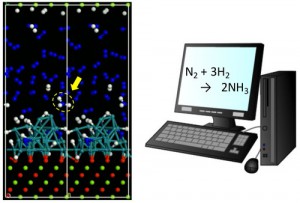[Published online Journal of Computer Chemistry, Japan Vol.15, 242-244, by J-STAGE]
<Title:> What Activates the Nitrogen Molecule in Ammonia Synthesis Using Supported Metal Catalysts ? A Quantum-Chemical Model Study
<Author(s):> Manabu SUGIMOTO
<Corresponding author E-Mill:> sugimoto(at)kumamoto-u.ac.jp
<Abstract:> The N-N bond breaking of the N2 molecule on a metal surface is the key process in the ammonia synthesis using heterogeneous catalysts. Herein we discuss electronic factors in the bond cleavage on the basis of electronic-structure calculations. It is shown that the hydrogenation of the end-on coordinated N2 molecule may play an important role, which may be accompanied by electron transfer from the catalyst to N2.
<Keywords:> Electronic-structure calculations, Ammonia synthesis, Catalysis, Supported metal catalyst, Surface adsorption
<URL:> https://www.jstage.jst.go.jp/article/jccj/15/6/15_2016-0062/_article/-char/ja/
<Title:> What Activates the Nitrogen Molecule in Ammonia Synthesis Using Supported Metal Catalysts ? A Quantum-Chemical Model Study
<Author(s):> Manabu SUGIMOTO
<Corresponding author E-Mill:> sugimoto(at)kumamoto-u.ac.jp
<Abstract:> The N-N bond breaking of the N2 molecule on a metal surface is the key process in the ammonia synthesis using heterogeneous catalysts. Herein we discuss electronic factors in the bond cleavage on the basis of electronic-structure calculations. It is shown that the hydrogenation of the end-on coordinated N2 molecule may play an important role, which may be accompanied by electron transfer from the catalyst to N2.
<Keywords:> Electronic-structure calculations, Ammonia synthesis, Catalysis, Supported metal catalyst, Surface adsorption
<URL:> https://www.jstage.jst.go.jp/article/jccj/15/6/15_2016-0062/_article/-char/ja/
